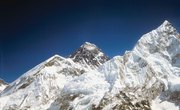
A landform can be defined as a naturally formed feature on Earth's surface. Landforms are an important point of focus in the study of geology as they give scientists insight into the history of our world. They are generally classified according to specific geologic attributes, such as elevation, location, stratification, slope, mineral content and age, among other factors. Mountains, canyons and valleys are types of landforms, but these aren't the ones.
Volcanic Landforms
These landforms are formed as a result of volcanic activity, or else they represent the various kinds of volcanoes and volcanic features themselves. Shield volcanos have slopes only a few degrees in steepness, and look like shields lying on the ground. Lava flows from these create the highest mountains on Earth. Strato-volcanos have the stereotypical cone-shaped mountain. These are structurally weak, and are associated with large avalanches. Caldera are marked by extremely violent eruptions that blast most of the lava out of the lava chamber, after which it collapses in on itself. A cinder cone is a small volcano only a few thousand feet high with limited eruptions.
Slope Landforms
Slope landforms are not necessarily formed as a result of volcanism but rather by tectonic activity or erosion. A butte--the term for which comes from the French word meaning "little hill"--is characterized by steep vertical edges and flat tops. A mesa takes its name from its table top shape similar to buttes, but larger. A plateau is a table-top shaped structure that is larger than both buttes and mesas. It forms as a result of tectonic activity. A cliff is a significant vertical or nearly vertical rock exposure. Cliffs are common in mountains and coastal areas.
Oceanic Landforms
Oceanic landforms include the topography of the ocean floor and coastal-related geological features. The continental shelf is the gently sloping submerged portion of the continental margin that extends from the shoreline to the continental slope. The continental slope is the steep gradient that leads to the ocean floor, and the continental rise is the gently sloping surface at the base of the continental slope. An oceanic trench is a narrow, elongated depression of the seafloor while an abyssal plain is the flat, level area of the deep ocean floor. A mid-ocean ridge is a mountainous ridge on the ocean floor of all major ocean basins.
Mountain and Glacial Landforms
Mountains and glaciers are formed during, or as a result of, mountain-forming processes. Glaciers themselves are powerful agents of large-scale geological change in the landscape and help shape many of the following. A rift valley is a long, narrow trough bounded by faults that represent a region where divergence is occurring. Glaciers are thick mass of ice originating on land from the compaction and recrystallization of snow. A crevasse is a deep crack in the brittle surface of a glacier. A cirque is an amphitheater-shaped basin at the head of a glaciated valley.
References
- Earth: An Introduction to Physical Geology by Edward J. Tarbuck and Frederick K. Lutgens
About the Author
Based in Olympia, Wash., Dustin Watson began writing professionally in 2006 while training at the American Writers and Arts Institute. He has been a finalist in several national writing awards, including the Philip Mangelsdorf Award for Writing Excellence. He is pursuing his Bachelor of Arts in psychology from the University of Washington.
Photo Credits
Photos.com/Photos.com/Getty Images
